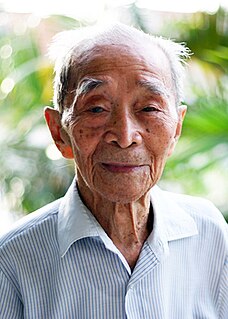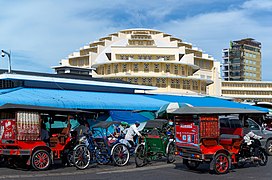
The system of Transport in Cambodia, rudimentary at the best of times, was severely damaged in the chaos that engulfed the nation in the latter half of the 20th century. The country's weak transport infrastructure hindered emergency relief efforts, exacerbating the logistical issues of procurement of supplies in general and their distribution. Cambodia received Soviet technical assistance and equipment to support the maintenance of the transportation network.

Phnom Penh, formerly known as Krong Chaktomuk Serimongkul or shortly known as Krong Chaktomuk, is the capital and most populous city in Cambodia. Phnom Penh has been the national capital since French colonization of Cambodia, and has grown to become the nation's economic, industrial, and cultural center.

The French Protectorate of Cambodia refers to the Kingdom of Cambodia when it was a French protectorate within French Indochina, a collection of Southeast Asian protectorates within the French Colonial Empire. The protectorate was established in 1863 when the Cambodian King Norodom requested the establishment of a French protectorate over his country, meanwhile Siam renounced suzerainty over Cambodia and officially recognised the French protectorate on Cambodia. Cambodia was integrated into the French Indochina union in 1887 along with the French colonies and protectorates in Vietnam. In 1946, Cambodia was granted self-rule within the French Union and had its protectorate status abolished in 1949. Cambodia later gained its independence and the independence day was celebrated on 9 November 1953.

The Kingdom of Cambodia, also known as the First Kingdom of Cambodia and the Sangkum Period, referred to Norodom Sihanouk's first administration of Cambodia from 1953 to 1970, an especially significant time in the country's history. Sihanouk continues to be one of the most controversial figures in Southeast Asia's turbulent and often tragic postwar history. From 1955 until 1970, Sihanouk's Sangkum was the sole legal party in Cambodia.

Ernest Hébrard (1875–1933) was a French architect, archaeologist and urban planner, best known for his urban plan for the center of Thessaloniki, Greece, after the great fire of 1917.

The Royal Palace, in Chey Chumneas, Phnom Penh, Cambodia, is a complex of buildings which serves as the royal residence of the king of Cambodia. Its full name in the Khmer language is Preah Barum Reachea Veang Chaktomuk Serei Mongkol. The Kings of Cambodia have occupied it since it was built in the 1860s, with a period of absence when the country came into turmoil during and after the reign of the Khmer Rouge.

Battambang or Krong Battambang is the capital city of Battambang province in northwestern Cambodia.

The National Museum of Cambodia in Chey Chumneas, Phnom Penh is Cambodia's largest museum of cultural history and is the country's leading historical and archaeological museum.
Media in Cambodia is vibrant and largely unregulated. This situation has led to the establishment of numerous radio, television and print media outlets. Many private sector companies have moved into the media sector, which represents a significant change from many years of state-run broadcasting and publishing.

Siem Reap is the capital city of Siem Reap Province in northwestern Cambodia.

Operation Eagle Pull was the United States military evacuation by air of Phnom Penh, Cambodia, on 12 April 1975. At the beginning of April 1975, Phnom Penh, one of the last remaining strongholds of the Khmer Republic, was surrounded by the Khmer Rouge and totally dependent on aerial resupply through Pochentong Airport. With a Khmer Rouge victory imminent, the US government made contingency plans for the evacuation of US nationals and allied Cambodians by helicopter to ships in the Gulf of Thailand. Operation Eagle Pull took place on the morning of 12 April 1975 and was a tactical success carried out without any loss of life. Five days later the Khmer Republic collapsed and the Khmer Rouge occupied Phnom Penh.

Mongkol Borey District is a district (srok) in the south of Banteay Meanchey Province, in northwestern Cambodia. The district capital is Mongkol Borey town, around nine kilometres south of the provincial capital of Sisophon by road. Mongkol Borey District is the southernmost district of Banteay Meanchey. The district shares a border with Battambang Province to the south. The main railway line from Phnom Penh to Poipet on the border with Thailand runs through the district from north to south.
Cambodia was a farming area in the first and second millennia BC. States in the area engaged in trade in the Indian Ocean and exported rice surpluses. Complex irrigation systems were built in the 9th century. The French colonial period left the large feudal landholdings intact. Roads and a railway were built, and rubber, rice and corn grown. After independence Sihanouk pursued a policy of economic independence, securing aid and investment from a number of countries. Bombing and other effects of the war during the Vietnam War damaged rice production. Lon Nol had a policy of liberalising the economy. This was followed by the victory of the Khmer Rouge and the emptying of the cities. After the defeat of the Khmer Rouge, a Five Year Plan was adopted, aiming to improve agriculture, industry and distribution, with a slogan of "export and thrift". Today, Cambodia remains a largely agricultural economy and industrial development is slow.

Psah Chas, also commonly spelt as Phsar Chas, Psar Chas or Psar Chaa, is a market in the city of Siem Reap in northern Cambodia. Not to be confused with the similarly named Psah Chas in Phnom Penh that is geared toward locals, this market in the south of the city caters to locals and tourists alike. The market is such a fixture in Siem Reap that many businesses give their address in relation to Psah Chas. The Khmer word "psah" ) is derived from "pasar" ("market"), either from Malay or Cham, both of which in turn derive from Persian "bazar".

New Khmer Architecture was coined by authors Helen Grant Ross and Darryl Leon Collins to describe an architectural movement in Cambodia during the 1950s and 1960s. The style blended elements of the Modern Movement with two distinctly Cambodian traditions: the grand tradition of Angkor, and the vernacular tradition of domestic buildings. The Kingdom of Cambodia gained independence from France in 1953. Winning the elections in 1955, Prince Norodom Sihanouk founded the Sangkum Reastr Niyum, a political experiment in economic development that went hand in hand with the arts in general, and this innovative architecture in particular. It reached its apotheosis in the 1960s and came abruptly to an end in 1970 with the overthrow of Norodom Sihanouk by Gen. Lon Nol.

A wat is a type of Buddhist temple and Hindu temple in Cambodia, Laos, East Shan State, Yunnan and Thailand. The word wat is a thai word that was borrowed from Sanskrit vāṭa, meaning 'enclosure'. The term has varying meanings in each region, sometimes referring to a specific type of government-recognised or large temple, other times referring to any Buddhist or Hindu temple.

Chau Sen Cocsal, also known as "Chhum", was a Cambodian civil servant and politician who served as interim Prime Minister of Cambodia in 1962 and President of the National Assembly twice, in 1962–1963 and 1966–1968. He lived for 103 years, 143 days, making him the longest-lived state leader in the world with the known date of birth and death. The only leader possibly longer living than him is another Cambodian Prime Minister, Ek Yi Oun (1910–2013). Chhum was awarded the honorary title "Samdech" in 1993 by King Norodom Sihanouk.

Cambodia has 612 km (380 mi) of 1,000 mm metre gauge rail network, consisting of two lines originally constructed during the time when the country was part of French Indochina. Due to neglect and damage from civil war during the latter half of the 20th century, the railways were in a dilapidated state and all services had been suspended by 2009. By 2016, freight and limited passenger service was available between Phnom Penh and Sihanoukville.

Sihanoukville, also known as Kampong Som, is a coastal city in Cambodia and the capital of Sihanoukville Province, at the tip of an elevated peninsula in the country's south-west on the Gulf of Thailand. The city is flanked by an almost uninterrupted string of beaches along its entire coastline and coastal marshlands bordering the Ream National Park in the east. The city has one navigable river, the mangrove lined Ou Trojak Jet running from Otres Pagoda to the sea at Otres. A number of thinly inhabited islands – under Sihanoukville's administration – are near the city, where in recent years moderate development has helped to attract a sizable portion of Asia's individual travelers, students, and backpackers.

The Central Post Office in Phnom Penh, Cambodia is a building erected during the French colonial period, serving as the head office of the Cambodian postal system.






















